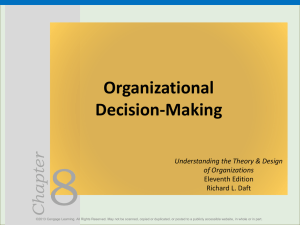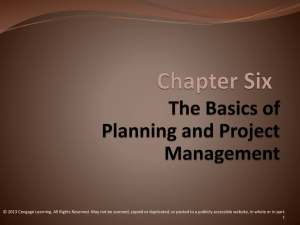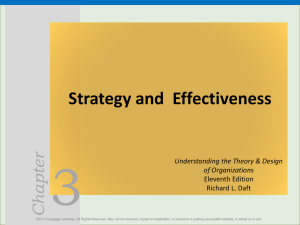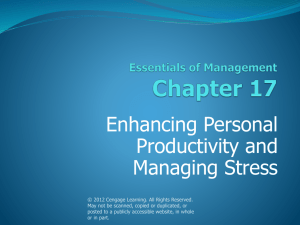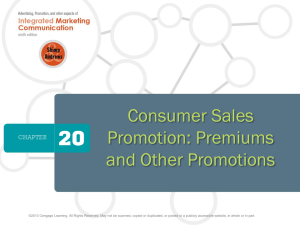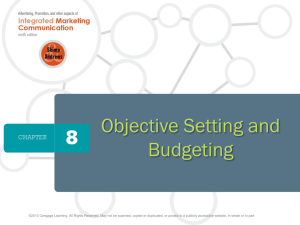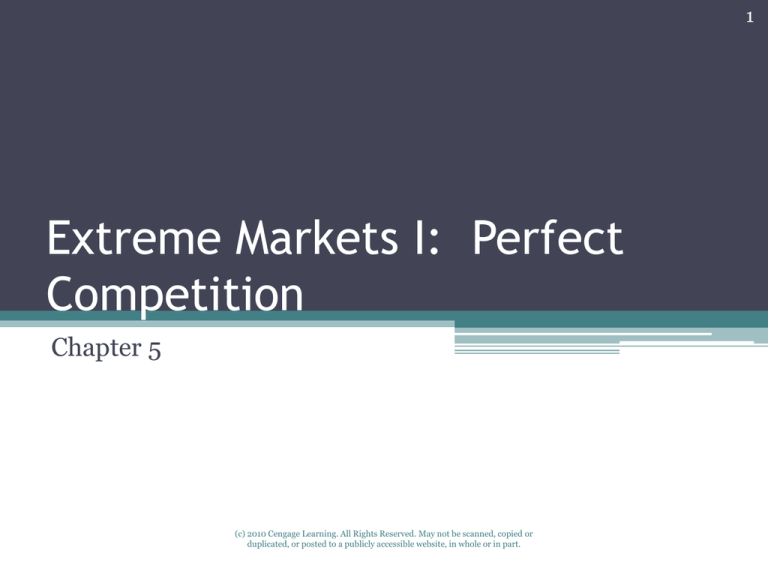
1
Extreme Markets I: Perfect
Competition
Chapter 5
(c) 2010 Cengage Learning. All Rights Reserved. May not be scanned, copied or
duplicated, or posted to a publicly accessible website, in whole or in part.
2
(c) 2010 Cengage Learning. All Rights Reserved. May not be scanned, copied or
duplicated, or posted to a publicly accessible website, in whole or in part.
3
The Ethanol Upheaval
In 2005 federal law
began requiring that
refiners add
“renewable” ethanol
into the nation’s
gasoline supply. This
requirement raises the
demand for corn, and
subsequently its price.
(c) 2010 Cengage Learning. All Rights Reserved. May not be scanned, copied or
duplicated, or posted to a publicly accessible website, in whole or in part.
4
What’s Ahead
This chapter is about perfectly competitive markets,
in which individual producers are so small relative to
the market that each of them is a price-taker that cannot
affect price by changing its output.
(c) 2010 Cengage Learning. All Rights Reserved. May not be scanned, copied or
duplicated, or posted to a publicly accessible website, in whole or in part.
5
(c) 2010 Cengage Learning. All Rights Reserved. May not be scanned, copied or
duplicated, or posted to a publicly accessible website, in whole or in part.
6
Substitutes and Competition –
Preferences and Prices
Substitutes help determine competition. A
set of producers is competitive if each
supplies a good substitute for what the
others produce.
(c) 2010 Cengage Learning. All Rights Reserved. May not be scanned, copied or
duplicated, or posted to a publicly accessible website, in whole or in part.
7
Substitutes and Competition – Who
Competes with Coke?
Does Coke compete with other carbonated beverage
producers like Pepsi and Dr. Pepper, or with the producers
of other beverages ranging from juice to bottled water?
(c) 2010 Cengage Learning. All Rights Reserved. May not be scanned, copied or
duplicated, or posted to a publicly accessible website, in whole or in part.
8
Price-Takers and Monopolies
Whatever a firm produces, their strategies are
constrained by customers’ abilities to substitute and
the abilities of rivals to expand or enter the industry.
A firm’s tactics to obtain an advantage next month
may center on one subset of these factors, while a
very different group of factors will help determine
their strategy for the next decade.
(c) 2010 Cengage Learning. All Rights Reserved. May not be scanned, copied or
duplicated, or posted to a publicly accessible website, in whole or in part.
9
(c) 2010 Cengage Learning. All Rights Reserved. May not be scanned, copied or
duplicated, or posted to a publicly accessible website, in whole or in part.
10
What We Assume, and Why
There are many sellers, all of whom are price-takers. No seller
is large enough to affect market price by its own actions.
Each seller produces a good or service that is perfectly
interchangeable with the output of any other; in other words,
the product is homogeneous.
Firms are not restricted from entering or leaving the industry in
response to profits or losses.
There are no important transaction costs. In particular,
information is available to all participants at no cost. Without
cost, buyers can learn the asking prices of sellers and sellers can
compare the bids of buyers.
(c) 2010 Cengage Learning. All Rights Reserved. May not be scanned, copied or
duplicated, or posted to a publicly accessible website, in whole or in part.
11
The Short Run and the Long Run
In the short run, all firms in the market have some
fixed inputs that must be paid for, regardless of whether
they are producing. In the long run all inputs are variable,
and fixed costs need no longer be incurred.
(c) 2010 Cengage Learning. All Rights Reserved. May not be scanned, copied or
duplicated, or posted to a publicly accessible website, in whole or in part.
12
(c) 2010 Cengage Learning. All Rights Reserved. May not be scanned, copied or
duplicated, or posted to a publicly accessible website, in whole or in part.
13
Identical Firms – A Shift in Demand
Initial long-run equilibrium is at 10,000 units produced in the market selling at a
price of $7.00. Individual firms will each produce 10 units.
When there is a permanent increase in demand to D2, price will rise to $16.00 and
existing firms will expand production to 11 units. Profit will attract entry which
will only stop when the market supply curve has shifted to SRS1500 and the
market price has once again fallen to $7.00.
(c) 2010 Cengage Learning. All Rights Reserved. May not be scanned, copied or
duplicated, or posted to a publicly accessible website, in whole or in part.
14
Identical Firms – An Increase in
Variable Costs
Here we begin in long-run equilibrium where the SRS1500 intersects the LRS at
15,000 units selling for $7.00. Each firm produces 10 units.
An increase in variable costs shifts the individual firm’s cost curves to MC’ and AC’.
The market supply curve shifts to SRS’1500. Price begins to rise above $7.00 but
firms are losing money and begin to exit the industry. Exit continues until market
supply is SRS’1100 and price rises to $16.00.
(c) 2010 Cengage Learning. All Rights Reserved. May not be scanned, copied or
duplicated, or posted to a publicly accessible website, in whole or in part.
15
Dissimilar Firms – A Shift in Demand
Here there are two types of firms facing different costs. If the
market demand curve is D1 only type A firms will exist in the
market. Demand would have to rise to D3 to attract type B firms
into the market.
(c) 2010 Cengage Learning. All Rights Reserved. May not be scanned, copied or
duplicated, or posted to a publicly accessible website, in whole or in part.
16
(c) 2010 Cengage Learning. All Rights Reserved. May not be scanned, copied or
duplicated, or posted to a publicly accessible website, in whole or in part.
17
Ethanol Again – Long-Run Adjustment
Say there are a small number of low-cost Type A producers and a limitless
potential number of high-cost Type Bs. We start in 2005 along demand curve
D1 at long-run equilibrium of 7,000 (million) bushels at a price of $7. The
ethanol requirement increases demand to D3.
With just type A firms the supply curve shifts to SRS1000, causing price to rise to
$22. This begins to attract type B firms to the industry and the entry of type B
firms will continue until price falls to $16.
(c) 2010 Cengage Learning. All Rights Reserved. May not be scanned, copied or
duplicated, or posted to a publicly accessible website, in whole or in part.
18
Ethanol Again – Corn Prices
(c) 2010 Cengage Learning. All Rights Reserved. May not be scanned, copied or
duplicated, or posted to a publicly accessible website, in whole or in part.
19
Ethanol Again – The Tortilla Effect
The graph on the left represents the market for corn in the US and the one on the
right the market in Mexico. Initially, suppose both markets are in equilibrium at a
price of $10. The ethanol regulation increase the demand for corn in the US to
D2US. The price for corn in the US rises to $16. Mexican producers have an
incentive to export corn. Eventually, the price of corn will settle at $13. The US
will produce 40 bushels for themselves and import 30 bushels from Mexico.
Mexicans are unhappy when the price of corn tortillas also increase!
(c) 2010 Cengage Learning. All Rights Reserved. May not be scanned, copied or
duplicated, or posted to a publicly accessible website, in whole or in part.
20
Oil and Gasoline
Pictured is a simplified market for
gasoline in the US. The domestic
demand is D. US refiners can
produce up to 1000 barrels at a
marginal cost of $7. Assume US
demand is small relative to global
demand so the US has little impact
on overall world demand.
Market price of $11 per barrel
prevails with 1500 barrels per
day, 1000 produced domestically
and 500 barrels imported.
(c) 2010 Cengage Learning. All Rights Reserved. May not be scanned, copied or
duplicated, or posted to a publicly accessible website, in whole or in part.
21
Oil and Gasoline – Effect of
Government Policies
In this example, domestic producers
produce at a marginal cost of $7 and
receive a price of $11 per barrel, for a
profit of $4 per barrel. Suppose a
domestic windfall profits tax of $4 is
imposed, who benefits?
The price of gasoline will not change.
Instead of producers, the government
will receive the $4 per barrel.
(c) 2010 Cengage Learning. All Rights Reserved. May not be scanned, copied or
duplicated, or posted to a publicly accessible website, in whole or in part.
22
Oil and Gasoline – Political Platforms
Suppose that US policy increased
domestic exploration. The
US supply curve would shift to
the right, reducing imports but
having no effect on the world
price.
(c) 2010 Cengage Learning. All Rights Reserved. May not be scanned, copied or
duplicated, or posted to a publicly accessible website, in whole or in part.



